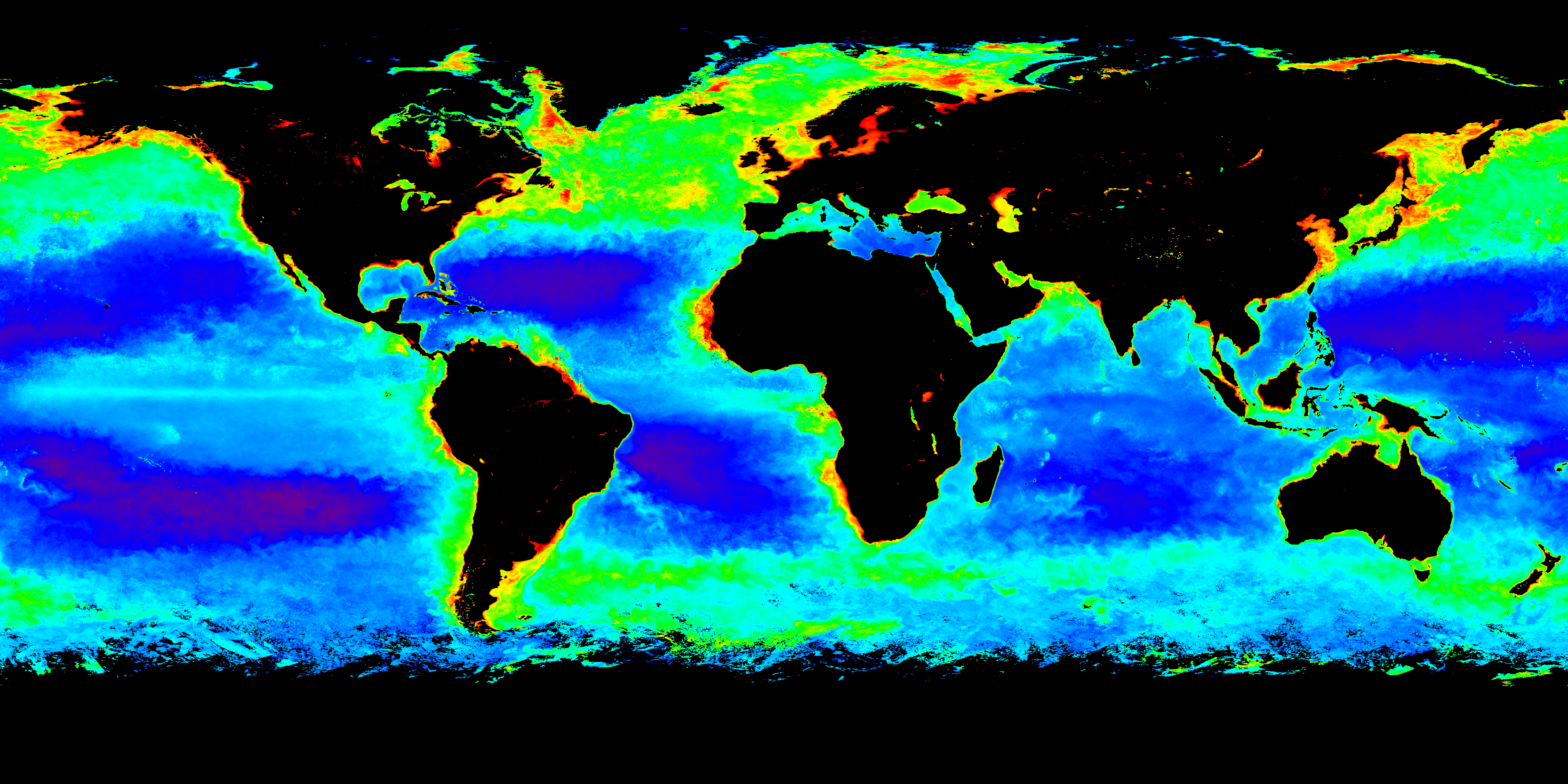This algorithm returns the near-surface concentration of chlorophyll-a (chlor_a) in mg m-3, calculated using empirical relationships derived from in situ measurements of chlor_a and remote sensing reflectances ($R_{rs}$). The implementation is contingent on the availability of three or more sensor bands spanning the 440 - 670 nm spectral regime. The algorithm is applicable to all current ocean color sensors. The chlor_a product is included as part of the standard Level-2 OC product suite and the Level-3 CHL product suite.
The current implementation for the standard chlorophyll product (chlor_a), as applied in version R2022 of NASA's multi-mission ocean color processing, is a blend between the updated OC3/OC4 (OCx) band ratio algorithm (O'Reilly and Werdell 2019) and the color index (CI) of Hu et al. (2019). The combined algorithm and theoretical basis is described in Hu et al. (2019), and the current implementation is detailed below.


Algorithm Point of Contact: P. Jeremy Werdell, NASA Goddard Space Flight Center; Chuanmin Hu, University of South Florida
$R_{rs}$ at 2-4 wavelengths between 440 and 670nm
chlor_a, concentration of chlorophyll a in mg m-3
The current standard chlor_a product is based on the algorithm of Hu et al.(2019), which combines an empirical band difference approach at low chorophyll concentrations with a band ratio approach at higher chlorophyll concentrations. The band difference approach is the color index or CI (Hu et al. 2019), and the band ratio approach is based on the OCx series of algorithms introduced in O'Reilley et al 1998, with updated coefficients from O'Reilley and Werdell (2019).
The algorithm proceeds as follows:
where the numerator, $R_{rs}(\lambda_{blue})$, is the greatest of several input $R_{rs}$ values and the coefficients, a0-a4, are sensor-specific (Table 1). In most cases these are taken directly from O’Reilley and Werdell (2019).
| sensor | Algorithm | OCx Rrs used (blue/green) |
a(0,1,2,3,4) |
|---|---|---|---|
| SeaWiFS | OC4, CI | Rrs(443>489>510)/Rrs555 | 0.32814; -3.20725; 3.22969; -1.36769; -0.81739 |
| MODIS | OC3M, CI | Rrs(443>488)/Rrs547 | 0.26294; -2.64669; 1.28364; 1.08209; -1.76828 |
| VIIRS-SNPP | OC3_VIIRS_SNPP, CI | Rrs(443>486)/Rrs551 | 0.23548; -2.63001; 1.65498; 0.16117; -1.37247 |
| VIIRS-NOAA20 | OC3_VIIRS_NOAA20, CI | Rrs(445>489)/Rrs556 | 0.28153; -2.65472; 1.30882; 1.31521; -2.08622 |
| VIIRS-NOAA21 | OC3_VIIRS_NOAA21, CI | Rrs(445>488)/Rrs555 | 0.24765; -2.54926; 1.55323; 0.39485; -1.54632 |
| MERIS | OC4E, CI | Rrs(443>489>510)/Rrs560 | 0.42487; -3.20974; 2.89721; -0.75258; -0.98259 |
| OCTS | OC4O, CI | Rrs(443>489>516)/Rrs565 | 0.54655; -3.51799; 3.39128; -0.91567; -0.97112 |
| GOCI | OC4,CI | Rrs(412>443>489)/Rrs555 | 0.28043; -2.49033; 1.53980; -0.09926; -0.68403 |
| HAWKEYE | OC4, CI | Rrs(447>488>510)/Rrs556 | 0.32814, -3.20725,3.22969, -1.36769, -0.81739 |
| OLCI | OC4, CI | Rrs(443>490>510)/Rrs560 | 0.42540; -3.21679; 2.86907; -0.62628; -1.09333 |
| CZCS | OC3, CI | Rrs(443>520)/Rrs555 | 0.31841; -4.56386; 8.63979; -8.41411; 1.91532 |
For the CI algorithm, the nearest band to 443, 555, and 670nm is used for the blue, green, and red band, respectively, for all sensors. For sensors that do not have a band very close to 555nm, a correction is performed to shift the nearest green band Rrs to 555nm. That correction is as follows:
For spectral bands (λ0) in the range of 543 –567 nm, Rrs(λ0) can be converted to Rrs(555) using the following equations:
If λ0 = 555±2nm,
$$ R_{rs}(555)=R_{rs}(\lambda_0)$$
If Rrs(λ0) < sw,
$$R_{rs}(555)=10^{(a_1*log_{10}(R_{rs}(\lambda_0))-b_1)}$$
If Rrs(λ0) ≥ sw,
$$R_{rs}(555)=a_2*R_{rs}(\lambda_0)-b_2$$
For different spectral bands (λ0), sw and a1, b1, a2, and b2 values are shown in table 2.
| Spectral range (λ0,nm) | sw | a1, b1 | a2, b2 |
|---|---|---|---|
| 543 - 547 | 0.001723 | 0.986; 0.081495 | 1.031; 0.000216 |
| 548 - 552 | 0.001597 | 0.988; 0.062195 | 1.014; 0.000128 |
| 558 - 562 | 0.001148 | 1.023; -0.103624 | 0.979; -0.000121 |
| 563 - 567 | 0.000891 | 1.039; -0.183044 | 0.971; -0.000170 |
Briefly, both chlorophyll products are computed and then blended with transition between the CI and OCx occurs at 0.25 < CI < 0.35 mg m-3. In some cases, where no update to OCx band ratio algorithm was offered by O'Reilly and Werdell 2019, coefficients stayed the same as in previous implementations. Older implementations were using O'Reilly et al. (1998) approach on deriving the coefficients from version 2 of the NASA bio-Optical Marine Algorithm Data set (NOMAD), merged with CI, using coefficients by Hu et al (2012), with the same transition zone (0.15 < CI < 0.2).
Hu, C., Lee, Z., & Franz, B. (2012). Chlorophyll a algorithms for oligotrophic oceans: A novel approach based on three-band reflectance difference . Journal of Geophysical Research, 117(C1). doi: 10.1029/2011jc007395
Hu, C., Feng, L., Lee, Z., Franz, B. A., Bailey, S. W., Werdell, P. J., & Proctor, C. W. (2019). Improving satellite global chlorophyll a data products through algorithm refinement and data recovery. Journal of Geophysical Research: Oceans, 124(3), 1524-1543, doi: 10.1029/2019JC014941
O'Reilly, J.E., Maritorena, S.,Mitchell, B. G., Siegel, D. A., Carder, K. L., Garver, S. A., Kahru, M., & McClain, C. R. (1998). Ocean color chlorophyll algorithms for SeaWiFS, Journal of Geophysical Research 103, 24937-24953, doi: 10.1029/98JC02160.
O'Reilly, J.E., & Werdell, P. J. (2019). Chlorophyll algorithms for ocean color sensors - OC4, OC5 & OC6. Remote Sensing of Environment, 229, 32-47. doi: 10.1016/j.rse.2019.04.021